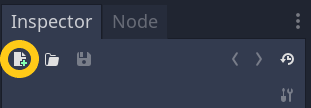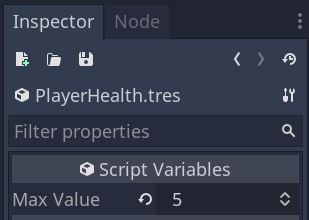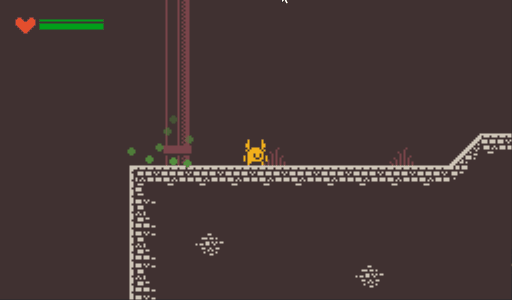Using Custom Resources
Problem
You’re looking for a way to handle data and/or create flexible data objects in your game.
Solution
Godot’s Resource class is a powerful tool for storing and working with data. Many of the most common objects you work with in Godot extend the Resource type: animations, collision shapes, images, etc. Resources not only contain data, but can also manipulate that data (if you’re familiar with the concept of scriptable objects in Unity, the concept is similar).
In addition to all of Godot’s built-in Resource types, you can create your own custom resources to handle your own game data. This has the benefit of abstracting and encapsulating data - creating something that can be used by any other object in your game.
Example: Player health
For this example, we’ll take the concept of player health in a platformer game. A lot of game systems interact with the player’s health. For example:
- The player may take damage when running into obstacles
- Enemies can damage the player when touching or shooting them
- The player can heal when picking up objects or standing in certain places
- The game’s UI needs to display the health and any changes that happen
In addition, there may be other interactions: maybe the game’s soundtrack changes as the player’s health gets low, or enemy behavior changes based on the player’s status.
This is an intentionally simplified example. In practice, you’ll probably need more functionality than we use here, or you’ll want to modify the example to fit with your game’s architecture.
First, we need to define our new custom resource, which we’ll call PlayerHealth. This resource needs to keep track of properties related to health. It also provides some functionality and signals to handle the changing of the health amount (such as healing and taking damage).
In the Script tab, choose File>New Script. Make sure it inherits Resource and name it PlayerHealth.gd.
Let’s break it down piece-by-piece:
At the top we have our extends line and the class_name we’re assigning to the resource. This name will appear in various places in the editor.
extends Resource
class_name PlayerHealth
Next we have a signal that game objects can subscribe to if they need to know when the player’s health changes. You could also add additional signals for the health reaching zero, etc.
signal health_changed
These are the properties we’ll be using.
export (int) var max_value
var current_value = 0
This function lets us initialize the health to the max value. You might do this at game restart or when starting a new level.
func reset():
current_value = max_value
This function should be called whenever damage is dealt to the player.
func take_damage(amount):
current_value = max(0, current_value - amount)
emit_signal("health_changed", current_value)
This function should be called whenever the player needs to be healed.
func heal(amount):
current_value = min(max_value, current_value + amount)
emit_signal("health_changed", current_value)
Here’s the full script:
extends Resource
class_name PlayerHealth
signal health_empty
signal health_changed
export (int) var max_value
var current_value = 0
func reset():
current_value = max_value
func take_damage(amount):
current_value = max(0, current_value - amount)
emit_signal("health_changed", current_value)
func heal(amount):
current_value = min(max_value, current_value + amount)
emit_signal("health_changed", current_value)
Creating a new resource
Once the PlayerHealth class is defined, we can make a new instance of it. Click the “New Resource” button at the top of the Inspector:
In the “Create New Resource” dialog you’ll see the long list of resource types. Searching will locate our PlayerHealth type.
Now you can set the desired max_value and save the new resource as a .tres file.
Using the resource
Once the resource has been created and saved, we’re ready to use it. Once again, in this scenario we have the following objects:
- Player - a
KinematicBody2D - UI - contains a
ProgressTextureto display health - Heal zone - an
Area2Dthat heals anything that stands in it - Spikes -
TileMaptiles that cause damage if touched
We won’t include all of the code for the game, just the parts that pertain to the health resource.
On the player, we export a variable to attach the resource via the Inspector. As part of the player’s movement code, it calls hurt() when the player runs into spikes.
export (Resource) var health
func _ready():
health.reset()
func hurt(amount):
# Called when running into obstacles
health.take_damage(amount)
The heal zone (an Area2D), affects anything inside it that has a health property:
func _physics_process(delta):
for body in get_overlapping_bodies():
if "health" in body:
body.health.heal(heal_rate * delta)
Finally, for the UI to display the health, we attach the same health resource and connect to its health_changed signal:
export (Resource) var player_health
func _ready():
if player_health:
player_health.connect("health_changed", self, "_on_player_health_changed")
func _on_player_health_changed(value):
healthbar.value = float(value) / player_health.max_value * 100
Here’s an example of it in action:
Download the project file here: custom_resources.zip



